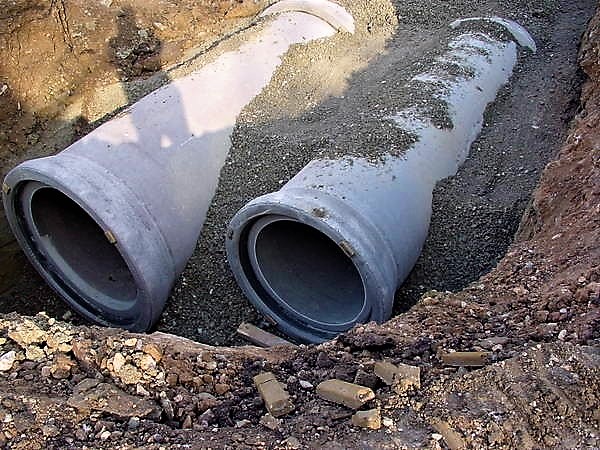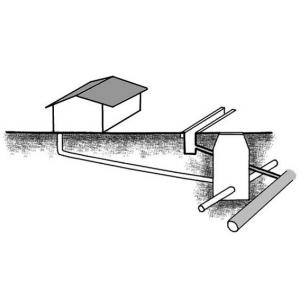Executive Summary
Separate sewerage consists in the separate collection of municipal wastewaters (blackwater from toilets, greywater and industrial wastewater) and surface run-off (rainwater and stormwater). The separate collection prevent the overflow of sewer systems and treatment stations during rainy periods and the mixing of the relatively little polluted surface run-off with chemical and microbial pollutants from the municipal wastewater. The design of the sewers and the (semi-)centralised treatment stations thus needs to consider the volume of the wastewater only and the surface run-off and rainwater can be reused (e.g. for landscaping or agriculture) after a simplified treatment.
| In | Out |
|---|---|
Precipitation, Blackwater, Faecal Sludge, Greywater, Brownwater, Urine or Yellowwater, Faeces, Non-biodegradable Wastewater |
Precipitation, Blackwater, Non-biodegradable Wastewater |
Basic design principles
Sewerage systems can be classified into combined sewerage (also known as conventional sewers) and separate sewerage. Combined sewerage carries both surface run-off and wastewater, while separate sewerage carries surface run-off and wastewater separately. Recent trends have been for the development of separate sewerage systems. By replacing the combined sewer systems with separate sewer systems, sewage and surface run-off can be managed in two separate systems. The main reason for this is that surface run-off is generally less polluted than wastewater, and that treatment of combined wastewater and surface run-off is difficult during heavy rainfalls, resulting in untreated overflows (commonly termed combined sewer overflow, UNEP and MURDOCH 2004). Controlling the surface run-off separately and avoiding combined sewer overflow,residents in low-lying areas in particular will avoid having their basements and ground floors flooded during extreme rain events. Should a rain event lead to flooding nonetheless, rainwater and not unsanitary sewage from kitchens and bathrooms will rise up into their basements.
Separation also eliminates the risk of sewage getting into the environment.Instead, it will be carried on to the treatment plants via a closed system, while storm water can be led to detention basins and watercourses (LADEN 2010). However, in practice there remains risk ingress of surface run-off into wastewater sewerage pipes, because of unsealed pipe joints, and unintentional or illegal connections of rainwater run-off. Conversely there may be unintentional or illegal wastewater connections to storm, water sewerage (UNEP & MURDOCH 2004).

Sewer separation has been used to eliminate combined sewer overflows for over 50 years. Today, separate sanitary sewer and storm water systems are more and more common. However, sewer separation is often said to be too disruptive, costly, and may result in an increase in pollutant loading to receiving waters as a result of the increased discharge of untreated surface run-off. Incomplete sewer separation efforts can also result in poor sanitary sewer system performance, including basement flooding and sanitary sewer overflows (TUIG et al. 2009).
Moreover, storm water drains in heavily urbanised areas may receive a variety of pollutants from rooftops, lorry loading bays, industrial sites and even from illegal connections to the surface water system. Therefore, publicity and inspections are needed to ensure that unexpected pollution does not arise from these sources (see also standards or restrictions). Pollutant loads discharged from urban storm water drainage systems not only vary depending on the urban structure, and the variety of materials entering the sewer network, but also on the local rainfall patterns and the processes of mixing and degradation that occur in the sewers. Hence, careful planning of the sewerage network is required to address these problems. Various modelling tools, such as rainfall modelling, sewer and sewage treatment modelling and river quality modelling, are now available to assist in this planning process (HELMER and HESPANHOL 1997).

Costs considerations
The construction costs might be higher than for the combined sewer system because two separated networks are necessary. These must also be maintained and operated separately. Also to replace the combined system by a separated system is very costly.
Operation and maintenance
(adapted from HELMER and HESPANHOL 1997)
Operation and maintenance (O&M) is an essential part of wastewater management and affects technology selection. Many wastewater treatment projects fail or perform poorly after construction because of inadequate O&M. On an annual basis, the O&M expenditures of treatment and sewage collection are typically in the same order of magnitude as the depreciation on the capital investment. Operation and maintenance requires:
- Careful exhaustive planning (specialised engineers).
- Qualified and trained staff devoted to its assignment.
- An extensive and operational system providing spare parts and O&M utilities.
- A maintenance and repair schedule, crew and facility.
- A management atmosphere that aims at ensuring a reliable service with a minimum of interruptions.
- A substantial annual budget that is uniquely devoted to O&M and service improvement.
Maintenance policy can be corrective, i.e. repair or action is undertaken when breakdown is noticed, but this leads to service interruption and hence dissatisfied customers. Ideally, maintenance is preventive, i.e. replacement of mechanical parts is carried out at the end of their expected lifetime. This allows optimal budgeting and maintenance schedules that have minimal impact on service quality. Clearly, O&M requirements are important factors when selecting a technology; process design should provide for optimal, but low cost, O&M.
Health aspects
Already the combined sewer system technology provides a high level of hygiene and comfort. A properly constructed separated system makes it even more secure, because the sewage is transported in a closed system directly to the treatment plant and cannot overflow into the environment. For general information about conventional sewers click here.
As for any sewer system, sufficient water needs to be available to carry the waste material in the sewers and therefore such systems are only applicable where enough water is available. This system is suitable for urban areas that have the resources to implement, operate and maintain such systems plus provide adequate treatment to avoid pollution at the discharge end (UNEP 2002). Separated sewers are especially suitable in areas where irregular, heavy rainfall is expected (e.g. monsoon). During these periods stormwater runoff can be managed separately and maybe stored for the dry season. Planning, construction, operation and maintenance require expert knowledge: a professional management system must be in place. When new systems are built, it is preferable to construct the separated system to prevent combined sewer overflow, limit the amount of highly-polluted wastewater and allow the reuse of surface water run-off.
Water Pollution Control - A Guide to the Use of Water Quality Management Principles
This document is rather old, but its publication was a milestone as it demonstrates WSSCCs capacity to bring together water and sanitation professionals from industrialised and developing countries to formulate practical guidance on a key issue of the day. Mainly regulatory, financial and technical aspects are discussed and illustrated with an extensive collection of case studies from the developing world.
HELMER, R. ; HESPANHOL, I. (1997): Water Pollution Control - A Guide to the Use of Water Quality Management Principles. World Health Organization (WHO), Water Supply and Sanitation Collaborative Council (WSSCC) and United Nations Environment Programme (UNEP) URL [Accessed: 21.04.2010]No more overloaded sewer systems
Over the coming 90 years, combined sewer systems will be phased out in the Municipality of Aalborg. Instead, the Municipality will introduce separate systems for stormwater and sewage.
LADEN, B. (2010): No more overloaded sewer systems. Copenhagen: Information Center for Climate Change Adaptation, Danish Ministry of Climate and Energy, Danish Energy Agency URL [Accessed: 28.05.2019]The Great Sewer Separation Debate
Environmentally sound technologies in wastewater treatment for the implementation of the UNEP/GPA "Guidelines on Municipal Wastewater Management"
Technical information on environmentally sound technologies in wastewater treatment.
UNEP ; MURDOCH UNIVERSITY (2004): Environmentally sound technologies in wastewater treatment for the implementation of the UNEP/GPA "Guidelines on Municipal Wastewater Management". The Hague: United Nations Environment Programme Global Programme of Action (UNEP/GPA), Coordination OfficeKanalplanung/Kanalbau
A Directory of Environmentally Sound Technologies for the Integrated Management of Solid, Liquid and Hazardous Waste for Small Island Developing States (SIDS) in the Pacific Region
This directory is part of UNEP collaboration with SIDS on the implementation of the Waste Management chapter of the Barbados Programme of Action. It focuses primarily on proven sound environmental technologies for solid, liquid and hazardous waste management plus those currently successfully being used in SIDS within the Pacific Region.
UNEP (2002): A Directory of Environmentally Sound Technologies for the Integrated Management of Solid, Liquid and Hazardous Waste for Small Island Developing States (SIDS) in the Pacific Region. The Hague: United Nations Environment Programme (UNEP) URL [Accessed: 28.03.2012]Water Pollution Control - A Guide to the Use of Water Quality Management Principles
This document is rather old, but its publication was a milestone as it demonstrates WSSCCs capacity to bring together water and sanitation professionals from industrialised and developing countries to formulate practical guidance on a key issue of the day. Mainly regulatory, financial and technical aspects are discussed and illustrated with an extensive collection of case studies from the developing world.
HELMER, R. ; HESPANHOL, I. (1997): Water Pollution Control - A Guide to the Use of Water Quality Management Principles. World Health Organization (WHO), Water Supply and Sanitation Collaborative Council (WSSCC) and United Nations Environment Programme (UNEP) URL [Accessed: 21.04.2010]Environmentally sound technologies in wastewater treatment for the implementation of the UNEP/GPA "Guidelines on Municipal Wastewater Management"
Technical information on environmentally sound technologies in wastewater treatment.
UNEP ; MURDOCH UNIVERSITY (2004): Environmentally sound technologies in wastewater treatment for the implementation of the UNEP/GPA "Guidelines on Municipal Wastewater Management". The Hague: United Nations Environment Programme Global Programme of Action (UNEP/GPA), Coordination OfficeNo more overloaded sewer systems
Over the coming 90 years, combined sewer systems will be phased out in the Municipality of Aalborg. Instead, the Municipality will introduce separate systems for stormwater and sewage.
LADEN, B. (2010): No more overloaded sewer systems. Copenhagen: Information Center for Climate Change Adaptation, Danish Ministry of Climate and Energy, Danish Energy Agency URL [Accessed: 28.05.2019]Water and Sewerage Services in Karachi. Citizen Report Card: Sustainable Service Delivery Improvements
This report discusses the key findings and recommendations emerging from a pilot Citizen Report Card (CRC) on water, sanitation, and sewerage services in Karachi. The CRC, pioneered by the Public Affairs Center (PAC), Bengaluru, provides public agencies with systematic feedback from users of public services. CRC gains such feedback through sample surveys on aspects of service quality that users know best, and enable public agencies to identify strengths and weaknesses in their work.
WSP (2010): Water and Sewerage Services in Karachi. Citizen Report Card: Sustainable Service Delivery Improvements. Washington: Water and Sanitation Program URL [Accessed: 03.10.2011]Rural Water Supply and Sanitation Challenges in Latin America for the Next Decade
Based on market research, this new WSP technical paper analyses the main features of the fecal sludge collection businesses in each city, including the marketing mix, potential demand, supply capacity, and legal frameworks. In addition, the paper spotlights major challenges and opportunities in fecal sludge management, describing the current and potential market for fecal sludge removal, collection, and disposal in peri-urban areas—which typically struggle with high population density, limited land planning, high citizen insecurity, and low coverage of basic services.
PEARCE-OROZ, G. (2011): Rural Water Supply and Sanitation Challenges in Latin America for the Next Decade. Lima: Water and Sanitation Program (WSP) URL [Accessed: 14.05.2012]Combined Sewer System
The Henderson Water Utility (HWU) webpage contains useful information which shows the difference between combined and separated sewer systems.


